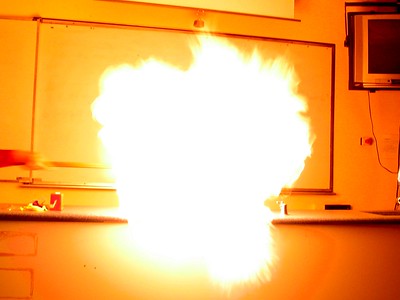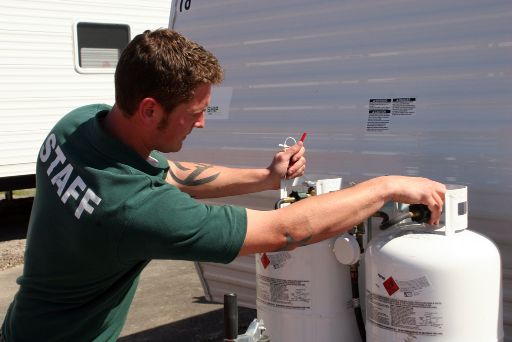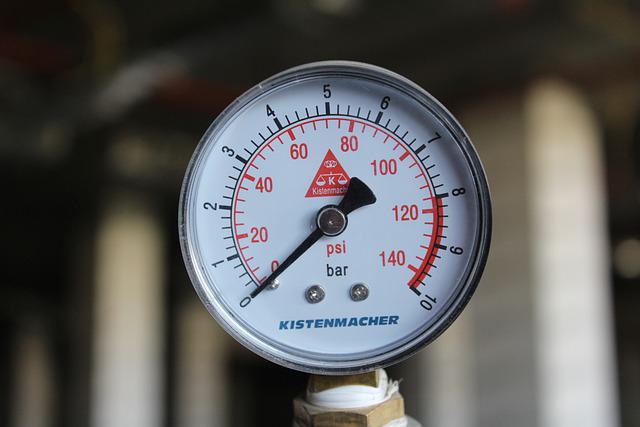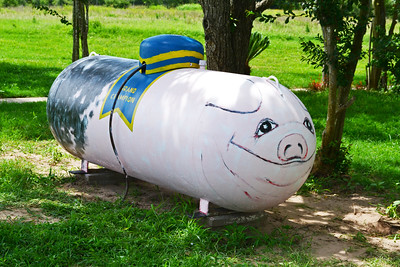
It is generally not safe to overfill a propane tank. If a propane tank is overfilled, the excess propane can escape and potentially create a dangerous situation. Propane is a flammable gas, and if it is released into the air in a confined space, it can create a risk of fire or explosion.
If a propane tank is overfilled, the excess gas can be released through the pressure-relief valve, which is designed to open and release excess pressure if the tank becomes too full. This can create a risk of fire or explosion if the gas is released near an open flame or other ignition sources.
It is important to follow the manufacturer’s instructions for filling propane tanks and to only fill the tank to the recommended level. If you suspect that your propane tank may be overfilled, it is important to take caution and have the tank checked by a qualified professional.
Signs of an Overfilled Propane Tank
Here are some signs that your propane tank may be overfilled:
- Unusual hissing or whistling sound: A hissing or whistling sound may indicate that there is too much pressure in the tank, which could be caused by overfilling.
- Swelling of the tank: An overfilled tank may cause the tank to physically expand or bulge.
- Leaking gas: Overfilling can cause gas to leak from the pressure relief valve, which is designed to release excess pressure from the tank.
- Strong odor of propane: An excessive buildup of propane inside the tank can cause a strong odor, which may be noticeable around the tank or near the fill valve.
- Difficulty lighting appliances: If you’re having trouble lighting your appliances, such as your stove or grill, it may be a sign that the tank is overfilled.
It’s important to address any signs of an overfilled propane tank immediately, as it can pose a potential safety hazard. If you suspect that your propane tank is overfilled, it’s best to evacuate the area and call the supplier or a professional to assess the situation.
What happens if the propane tank is overfilled?
If a propane tank is overfilled, excess gas will be released from the tank. This can create a fire hazard, as the gas that is released can ignite if it comes into contact with a flame or other ignition source. Additionally, the pressure inside the tank could become too high, which could cause the tank to rupture or explode.
Overfilling a propane tank can also cause it to freeze, which can lead to problems with the gas supply to your appliances. It is important to follow the manufacturer’s instructions for filling a propane tank and to have it filled by a trained professional to avoid these hazards.
Do Propane Tanks Have Overfill Protection?
One potential hazard associated with propane tanks is the risk of overfilling. When a propane tank is overfilled, excess gas is released from the tank, which can create a fire hazard. Additionally, the pressure inside the tank could become too high, which could cause the tank to rupture or explode. To help prevent these hazards, most propane tanks are equipped with an overfill protection device (OPD).
The OPD is a valve that is located on the top of the propane tank, and it is designed to automatically shut off the flow of propane into the tank when it reaches 80% of its capacity. This helps to prevent the tank from being overfilled and reduces the risk of fire or explosion. The OPD is a safety feature that is required by law on all propane tanks that are used for consumer purposes in the United States.
It is important to note that the OPD will only work if it is functioning properly, so it is important to periodically inspect and maintain your OPD to ensure that it is in good working order. This may involve cleaning the valve and testing it to ensure that it is functioning properly.
In addition to the OPD, there are other steps that you can take to help prevent your propane tank from being overfilled. One of the most important things you can do is to follow the manufacturer’s instructions for filling the tank. This may involve taking the tank to a trained professional who can fill it safely. You should also avoid filling the tank beyond the recommended level, as this can increase the risk of overfilling.
Another important safety precaution is to store your propane tank in a safe location, away from any potential ignition sources. This may include keeping the tank away from heat sources, such as stoves or furnaces, as well as away from open flames, such as cigarettes or candles.
How Full Can a Propane Tank be Filled?
In general, it is not recommended to fill a propane tank beyond 80% of its capacity. This is because excess gas can be released from the tank if it is overfilled, which can create a fire hazard. Additionally, the pressure inside the tank could become too high, which could cause the tank to rupture or explode.
To help prevent overfilling, most propane tanks are equipped with an overfill protection device (OPD). The OPD is a valve that is located on the top of the propane tank, and it is designed to automatically shut off the flow of propane into the tank when it reaches 80% of its capacity. This helps to prevent the tank from being overfilled and reduces the risk of fire or explosion.
It is important to follow the manufacturer’s instructions for filling a propane tank, as the recommended fill level may vary depending on the size and type of tank you are using. In general, it is a good idea to have your propane tank filled by a trained professional, as they are familiar with the proper filling procedures and can help ensure that the tank is filled safely.
In addition to following the manufacturer’s instructions and having the tank filled by a professional, there are other steps you can take to ensure the safe and proper use of your propane tank. One of the most important things you can do is to regularly check the level of propane in your tank and have it refilled when necessary. This will help ensure that you have a reliable fuel source for your appliances and that you are not at risk of running out of gas.
Can You Overfill a Propane Tank?
It is generally not safe to overfill a propane tank. If a propane tank is overfilled, excess gas will be released from the tank, which can create a fire hazard. Additionally, the pressure inside the tank could become too high, which could cause the tank to rupture or explode. To help prevent overfilling, most propane tanks are equipped with an overfill protection device (OPD), which is a valve that is designed to automatically shut off the flow of propane into the tank when it reaches 80% of its capacity.
However, it is still possible to overfill a propane tank if the OPD is not functioning properly or if the tank is filled beyond the recommended level. For this reason, it is important to follow the manufacturer’s instructions for filling a propane tank and to have it filled by a trained professional. It is also a good idea to periodically check the level of the propane in your tank to ensure that it is not overfilled.
What to Do If Your Propane Tank is Overfilled?
If you suspect that your propane tank has been overfilled, it is important to take immediate action to reduce the risk of fire or explosion. Here are some steps you should take if you think your propane tank is overfilled:
- Move the tank to a safe location: If the tank is near an ignition source, such as a stove or furnace, move it to a safe location away from any potential ignition sources.
- Vent the excess gas: To release the excess gas from the tank, carefully open the valve on top of the tank. Be sure to do this in a well-ventilated area to help dissipate the gas.
- Contact a trained professional: If you are not sure how to safely vent the excess gas from the tank, or if you are unable to do so, contact a trained professional for assistance. They will be able to safely release the excess gas and ensure that the tank is filled to the proper level.
- Check the OPD: If the overfill was caused by a malfunctioning OPD, you may need to have the valve repaired or replaced. A trained professional will be able to inspect the OPD and recommend any necessary repairs or replacements.
It is important to handle propane tanks with care to avoid the risk of fire or explosion. If you suspect that your propane tank is overfilled, follow the steps above to reduce the risk of hazards and seek the help of a trained professional if necessary.
To Make a Conclusion
An overfilled propane tank can pose a potential safety hazard as it can cause gas to leak and increase the risk of an explosion. Overfilling can occur when too much propane is added to the tank, creating excess pressure that can cause the tank to expand or bulge, leak gas, and emit a strong odor. It’s important to be aware of the signs of an overfilled propane tank and to take immediate actions to evacuate the area, call for help, and turn off any sources of ignition. With proper care and attention, you can avoid overfilling and ensure the safe and efficient use of your propane tank.

Mike is an experienced propane technician with over 15 years of professional experience in the field. He has dedicated his career to helping customers with their propane needs, from installation to maintenance and repair. Together with Jeremy, he co-founded this website to provide useful information and guidance to customers seeking reliable propane services.




